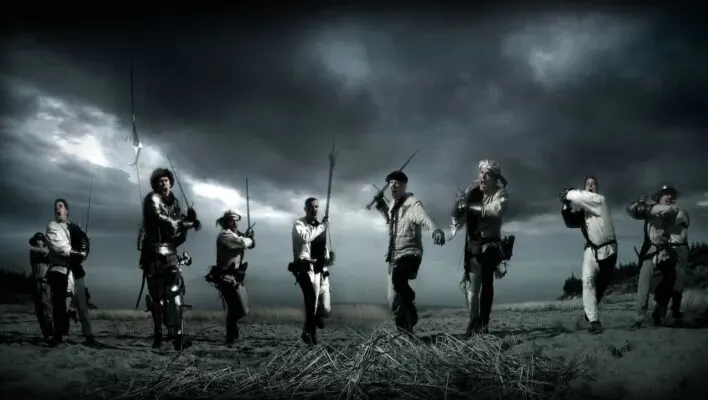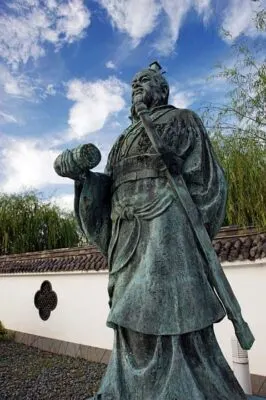
Very few books have a more enduring legacy than The Art of War by Sun Tzu. Even though it was published two thousand years ago, contemporary audiences still read and appreciate it. So why has this book remained relevant and famous over the years? What is the Art of War all about?
The Art of War is an influential book about tactical warfare and military strategies. The book covers opponent psychology and how to exploit their weaknesses, when to attack and when to retreat, how to handle a range of terrains, and how a general should lead his troops.
The world of warfare and combat has evolved dramatically since the time of Sun Tzu. But the teachings are still influencing leaders around the world today. Keep reading for a detailed breakdown of this book and some of its biggest lessons.
What is Sun Tzu’s Art of War Book?
The Art of War was written by Chinese general Sun Tzu during the Warring States Period between 471 and 21 BCE. It’s based on military tactics and how generals should deal with situations. Today, this book is studied by a wide range of people for its psychological insights.

Photo by 663highland
Due to its age, it’s hard to pinpoint when this book was written. But the best guesses place it between 471 and 21 BCE. This was during a turbulent time in China’s history, known as the Warring States Period. This name was chosen because several kingdoms were vying for control.
The conflict allowed Sun Tzu to refine his military tactics. However, little is known about the author. He was likely a high-ranking general in the Wu state who had a clear understanding of military techniques and strategies.
Today, though, this book continues to inspire countless people around the world. For example, Chairman Mao, the leader of China, cites it as an influential novel. Many military leaders are known to have read its contents and used it to inspire their approaches to conflict.
Sun Tzu’s book on battlefield strategy, “The Art of War”, has been required reading for the thoughtful military officer for more than 2,500 years.
Smith, S. V. (2018, August 24).NPR.
What Are the Main Lessons of Art of War?
There are several key lessons that Sun Tzu tries to impart during Art Of War; these include:
- Avoid lengthy sieges. He argues that this will wear down both the attacking and opposing armies. It’s best to seek victory as quickly as possible.
- Know your opponent. If you study your opponent, you can create a strategy that uses their weaknesses against them. Ideally, you should only attack once you are certain you can win. If you can’t win, you should retreat.
- Control your opponent. Leaders should try to deceive and manipulate their opponents, tricking them into moving into traps that exploit their weaknesses. It’s important to know when to defend and when you should be attacking.
- Divide and conquer. A united army will win more easily if they can divide the enemy into smaller factions.
- Remain flexible. In combat, there are always unprecedented situations. Sticking too rigidly to a plan can cause leaders to fall for traps or to miss potentially valuable opportunities.
LEARN MORE: What Is Verbal Judo for Police? The Gentle Art of Persuasion Explained
What Are the Famous Quotes from “The Art of War”?
Numerous quotes sum up Sun Tzu’s approach to conflict; some of the most popular are:
- If you know the enemy and know yourself, you need not fear the result of a hundred battles. If you know yourself but not the enemy, for every victory gained, you will also suffer a defeat. You will succumb in every battle if you know neither the enemy nor yourself.
- To secure ourselves against defeat lies in our own hands, but the enemy himself provides the opportunity of defeating the enemy.
- The clever combatant imposes his will on the enemy but does not allow the enemy’s will to be imposed on him.
- Let your plans be dark and impenetrable as night, and when you move, fall like a thunderbolt.
ALSO READ: What Did Bruce Lee Mean By “Be Like Water?” Simply Explained
How Does the Art of War Apply to Combat Sports?
The most prominent topics covered in Art of War relevant to fighters in combat sports are; understanding your opponent’s motivations, how to manipulate them, deciding when to attack, and learning how to gain a tactical advantage over the opposition.
The main target for The Art of War is military commanders. But the principles in this book have meaning for everyone involved with combat sports. It contains a lot of insight into how your opponent thinks. It delves into how you can use psychology to your benefit. For example, how you can lure your opposition into making a mistake. It also talks about when you should attack your opponent and when it’s the right time to retreat.
In the world of combat sports, this will often be done by studying previous matches and looking for weaknesses that you can exploit. It’s also important to reflect on your previous fights and consider how you can create a more effective attack in the future.
In The Art of War, Sun Tzu said, “Let your plans be as dark and impenetrable as night.” This lesson focuses on the importance of keeping your plans hidden from your opponent, which MMA fighters always do by keeping their game plans secret.
In doing so, you keep your opponent guessing about your fighting strategy throughout the fight. This makes it easier to manipulate your opponent, forcing them into situations that benefit you. For example, your opponent expected you to use more jiu-jitsu techniques, but you completely surprised them by attacking with more striking.
Lastly, this book goes into depth about the terrain and how armies can use it to their advantage. This mindset also applies within a fight. For example, if you keep the cage or ropes to your back, you can stop your opponent from attacking you from behind.
In the video below, UFC champion Henry Cejudo explains how “the art of war” strategy can be used in combat sports to defeat your opponent.
Who Should Read the Art of War?
The Art of War is a highly recommended book for military and civilian leaders and combat athletes. Those in military and government leadership roles can gain valuable insights from the various approaches and tactics taught in the book. Those in combat sports can gain insight into their opponent’s mindset.
Given the book’s nature, it has influenced military leaders in particular, but its words of advice can also apply to business leaders as well as combat sports players. Combat athletes would particularly enjoy the sections of the book that deal with the psychology of fighting. Sun Tzu talks about how a strong leader should behave and how to build a loyal group. These lessons can be adapted to fit the corporate world as well as those within the government.
Lastly, an average joe can also gain wisdom from the Art of War because it is all about useful tactics and strategies rather than a specific warfare technology. The philosophical insights can be used for self-improvement. For example, Sun Tzu discusses why you should be prepared for anything life might throw your way.
Final Thoughts
The Art of War has truly stood the test of time, describing the psychology of conflict and the tactics required to win any battle. Even more remarkably, this novel is useful outside the military sphere. It has been used by athletes, business leaders, politicians, and regular people searching for a way to improve their lives.
